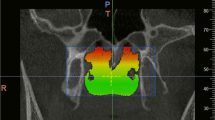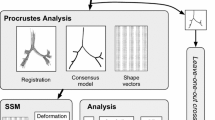Abstract
Purpose
The nasal septum presents inter-individual conformational variations. The objectives of this study were to establish a validated protocol for nasal septum analysis using geometric morphometrics (GM) to establish a classification of septal deviations (SD).
Methods
This was a retrospective study including two groups of patients: patients operated on by septoplasty (SD group) and patients without nasal obstruction (control group). The 3D segmentation model was extracted from CT scans. Thirty landmarks were defined on the nasal septum and validated by MANOVA Procrustes. Using a clusterization process, the septum was classified to reflect its different conformations. Nasal resistances were compared between the two groups.
Results
Fifty scans of patients with SD were included. The percentage of variability due to measurement error was 7.9% across all landmarks. We identified two clusters for the SD group. Using GM, conformation of cluster 1 (S-shaped) and cluster 2 (C-shaped) was visualized and identified. There was a statistically significant difference regarding nasal resistance between each cluster in the SD group compared with the control group (p < 0.05).
Conclusions
This work is a first step in SD exploration, contributing to a clearer appreciation of the interactions between nasal conformation and function. An SD classification was devised based on a reliable and reproducible statistical analysis. Enhanced understanding of conformation/function interactions will improve the diagnosis and treatment of nasal obstruction.






Similar content being viewed by others
References
Baumann I, Baumann H (2007) A new classification of septal deviations. Rhinology 45(3):220–223
Bookstein F (1982) Foundations of morphometrics. Annu Rev Ecol Evol Syst 13:451–470
Bookstein F (1993) Morphometric tools for landmark data: geometry and biology. J Classif 10(1):133–136
Bookstein F (1997) Landmark methods for forms without landmarks: morphometrics of group differences in outline shape. Med Image Anal 1:225–243
Buyukertan M, Keklikoglu N, Kokten G (2003) A morphometric consideration of nasal septal deviations by people with paranasal complaints: a computed tomography study. Rhinology 41:21–24
Cottle M, Loring G, Fischer Gaynon I (1958) The maxilla–premaxilla approach to extensive nasal septum surgery. AMA Arch Otolaryngol 68:301–313
Goergen M, Holton N, Grünheid T (2017) Morphological interaction between the nasal septum and nasofacial skeleton during human ontogeny. J Anat 230(5):689–700
Grymer L, Melsen B (1989) The morphology of the nasal-septum in identical-twins. Laryngoscope 99(6):642–646
Guyomarc’h P, Santos F, Dutailly B, Desbarats P, Bou C, Coqueugniot H (2012) Three-dimensional computer-assisted craniometrics: a comparison of the uncertainty in measurement induced by surface reconstruction performed by two computer programs. Forensic Sci Int 219(1–3):221–227
Guyuron B (1999) A practical classification of septonasal deviation and an effective guide to septal surgery. Plast Reconstr Surg 104(7):2202–2210
Heimer D (1983) Sleep apnea syndrome treated by repair of deviated nasal septum. Chest J 84(2):184
Kendall DG (1984) Shape manifold, procrustean metrics and complex projective spaces. Bull Lond Math Soc 16:81–121
Kim J, Cho JH, Kim SW, Kim BG, Lee DC, Kim SW (2010) Anatomical variation of the nasal septum: correlation among septal components. Clin Anat 23(8):945–949
Krajina Z, Bumber Z (1982) Contribution to nasal-septum deformities. Acta Oto-Laryngol 93(3–4):291–294
Michel J, Paganelli A, Varoquaux A, Piercecchi-Marti MD, Adalian P, Leonetti G, Dessi P (2015) Determination of sex: interest of frontal sinus 3D reconstructions. J Forensic Sci 60(2):269–273
Miles B, Petrisor D, Kao H, Finn R, Throckmorton G (2007) Anatomical variation of the nasal septum: analysis of 57 cadaver specimens. Otolaryng Head Neck 136:362–368
Mladina R, Skitarelic N, Poje G, Subaric M (2015) Clinical implications of nasal septal deformities. Balk Med J 32:137–146
Moreddu E, Puymerail L, Michel J, Achache M, Dessi P, Adalian P (2013) Morphometric measurements and sexual dimorphism of the piriform aperture in adults. Surg Radiol Anat 35(10):917–924
Oxnard C, O’Higgins P (2009) Biology clearly needs morphometrics. Does morphometrics need biology? Biol Theory 4(1):84–97
Rao J, Kumar E, Babu K, Chowdary V, Singh J, Rangamani S (2005) Classification of nasal septal deviations—relation to sinonasal pathology. Indian J Otolaryngol 57(3):199
Roithmann R, Cole P, Chapnik J, Shpirer I, Hoffstein V, Zamel N (1995) Acoustic rhinometry in the evaluation of nasal obstruction. Laryngoscope 105(3):275–281
Teixeira J, Certal V, Chang ET, Camacho M (2016) Nasal septal deviations: a systematic review of classification systems. Plast Surg Int 2016:7089123
Tomasi M (1997) The deviated nose. Classification and treatment. A propos of 100 cases. Ann Otolaryngol Chir Cervicofac 114(1–2):41–50
Zeng W, Chen G, Ju R, Yin H, Tian W, Tang W (2018) The combined application of database and three-dimensional image registration technology in the restoration of total nose defect. J Craniofac Surg 29(5):e484–e487
Verhoeven S, Schmelzer B (2016) Type and severity of septal deviation are not related with the degree of subjective nasal obstruction. Rhinology 54(4):355–360
Ward JH (1963) Hierarchical grouping to optimize an objective function. J Am Stat Assoc 58(301):236–244
Wee JH (2012) Classification and prevalence of nasal septal deformity in Koreans according to two classification systems. Acta Otolaryngol 132(1):52–57
Funding
None.
Author information
Authors and Affiliations
Contributions
TR: main author. DH, PD: data collection. PA: statistics. JM: study design
Corresponding author
Ethics declarations
Conflict of interest
The authors declare that they have no conflict of interest.
Additional information
Publisher's Note
Springer Nature remains neutral with regard to jurisdictional claims in published maps and institutional affiliations.
Rights and permissions
About this article
Cite this article
Radulesco, T., Hazbri, D., Dessi, P. et al. Geometric morphometric contribution to septal deviation analysis. Surg Radiol Anat 41, 823–831 (2019). https://doi.org/10.1007/s00276-019-02235-6
Received:
Accepted:
Published:
Issue Date:
DOI: https://doi.org/10.1007/s00276-019-02235-6




